
Accordions are a family of box-shaped musical instruments of the bellows-driven free-reed aerophone type, colloquially referred to as a squeezebox. A person who plays the accordion is called an accordionist. The concertina and bandoneón are related. The harmonium and American reed organ are in the same family, but are typically larger than an accordion and sit on a surface or the floor.
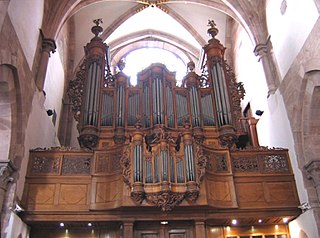
In music, the organ is a keyboard instrument of one or more pipe divisions or other means for producing tones, each played with its own keyboard, played either with the hands on a keyboard or with the feet using pedals.

Willebroek is a municipality located in the Belgian province of Antwerp. The municipality comprises the towns of Blaasveld, Heindonk, Tisselt, Klein Willebroek, and Willebroek proper. On January 1, 2006, Willebroek had a total population of 23,044. The total area is 27.41 km² which gives a population density of 841 inhabitants per km².
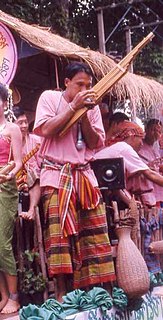
The khene “khene lao” is a mouth organ whose pipes, which are usually made of bamboo, are connected with a small, hollowed-out hardwood reservoir into which air is blown. The khene is the national instrument of Laos. The khene music is an integral part of Lao life that promotes family and social cohesion and it was inscribed in 2017 on the UNESCO Representative List of the Intangible Cultural Heritage of Humanity. Today associated with the Lao people of Laos and Isan, other similar instruments date back to the Bronze Age. In Cambodia, it is used among the ethnic Lao population of the province of Stung Treng and is used in lakhon ken, a Cambodian dance drama genre that features the khene as the premiere instrument. In Vietnam, this instrument is used among the Tai peoples and the Muong people. The most interesting characteristic of the khene is its free reed, which is made of brass or silver. It is related to Western free-reed instruments such as the harmonium, concertina, accordion, harmonica, and bandoneon, which were developed beginning in the 18th century from the Chinese sheng, a related instrument, a specimen of which had been carried to St. Petersburg, Russia.

A free reed aerophone is a musical instrument that produces sound as air flows past a vibrating reed in a frame. Air pressure is typically generated by breath or with a bellows. In the Hornbostel–Sachs system, it is number: 412.13. Free reed instruments are contrasted with non-free or enclosed reed instruments, where the timbre is fully or partially dependent on the shape of the instrument body, Hornbostel–Sachs number: 42.

Dredging is the excavation of material from a water environment. Possible reasons for dredging include improving existing water features; reshaping land and water features to alter drainage, navigability, and commercial use; constructing dams, dikes, and other controls for streams and shorelines; and recovering valuable mineral deposits or marine life having commercial value. In all but a few situations the excavation is undertaken by a specialist floating plant, known as a dredger.
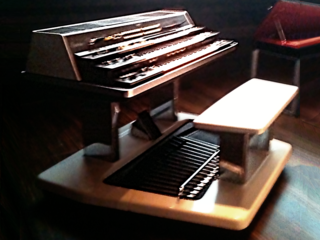
An electric organ, also known as electronic organ, is an electronic keyboard instrument which was derived from the harmonium, pipe organ and theatre organ. Originally designed to imitate their sound, or orchestral sounds, it has since developed into several types of instruments:
A harmonium or pump organ is a reed organ that generates sound with foot- or hand-pumped bellows.
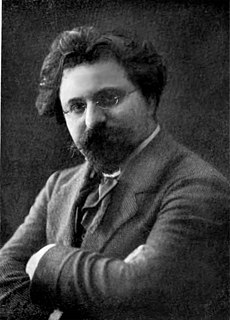
Sigfrid Karg-Elert was a German composer in the early twentieth century, best known for his compositions for pipe organ and reed organ.
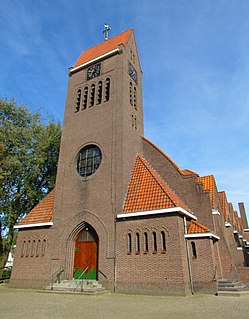
Barger-Compascuum is a village in the Dutch municipality of Emmen. It is in a peat-producing region of Drenthe. Veenpark, an open-air museum, is dedicated to the peat history of the region.

The pump organ is a type of free-reed organ that generates sound as air flows past a vibrating piece of thin metal in a frame. The piece of metal is called a reed. Specific types of pump organ include the reed organ, harmonium, and melodeon. The idea for the free reed was imported from China through Russia after 1750, and the first Western free-reed instrument was made in 1780 in Denmark.
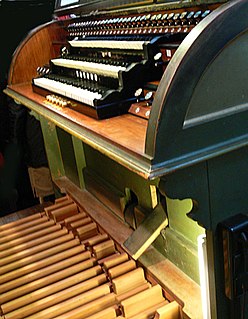
An expression pedal is an important control found on many musical instruments including organs, electronic keyboards and pedal steel guitar. The musician uses the pedal to control different aspects of the sound, commonly volume. Separate expression pedals can often be added to a guitar amplifier or effects unit and used to control many different aspects of the tone.

The regal is a small portable organ, furnished with beating reeds and having two bellows. The instrument enjoyed its greatest popularity during the Renaissance. The name was also sometimes given to the reed stops of a pipe organ, and more especially the vox humana stop.

Starting its activities in 1813, the Royal Conservatory of Brussels received its official name in 1832. Providing performing music and drama courses, the institution became renowned partly because of the international reputation of its successive directors such as François-Joseph Fétis, François-Auguste Gevaert, Edgar Tinel, Joseph Jongen or Marcel Poot, but more because it has been attended by many of the top musicians, actors and artists in Belgium such as Arthur Grumiaux, José Van Dam, Sigiswald Kuijken, Josse De Pauw, Luk van Mello and Luk De Konink. Adolphe Sax, inventor of the saxophone, also studied at the Brussels Conservatory.

The seraphine is an early keyed wind instrument, something of a cross between a reed organ and an accordion, being more similar to the former. It makes its sound via the action of air being blown across metallic reeds.

German Jubilate Harmonium Reeds are brass reeds used in Indian harmoniums that were manufactured in Germany between 1911 and the early 1960s. The reeds were originally manufactured for American style suction reed organs being manufactured in Germany on machinery that was bought second hand in Chicago in the United States and imported to Germany by Karl Mannborg son of Theodor Mannborg. Mannborg owned the factory in Pegau, Germany supplying organ parts for American style suction reed organs. Germany was the only country in Europe that was manufacturing American style suction reed organs while the rest of the reed organ industry in Europe was making pressure reed Harmoniums.

Without Words is the first remix album by California-based worship collective Bethel Music, and it is also the fifth album overall to be released. The album was released on March 5, 2013 by the group's imprint label, Bethel Music alongside Integrity Music. Garrett Viggers and Gabriel Wilson produced the album together.
The Organ collection Ghysels is a museum collection of mechanical dance and fairground organs. Since 2010 it is exhibited at the Kijk- en Luisterdepot in Kallo in Beveren, Belgium. It was brought together by Jef Ghysels from Schaerbeek. Great part of the organs operated before the First World War.
















